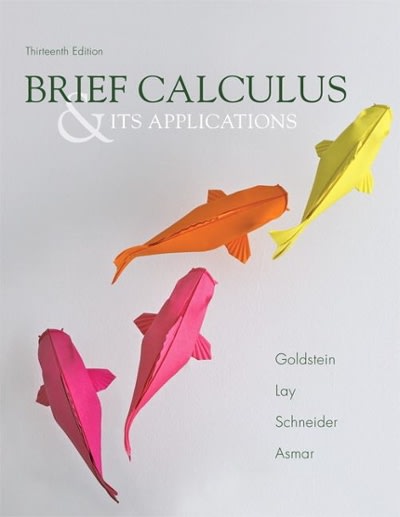Question
3. In each case state whether you expect the two variables x and y indicated to have positive, negative, or zero correlation and why. a.
3. In each case state whether you expect the two variables x and y indicated to have positive, negative, or zero correlation and why.
a. the number x of pages in a book and the age y of the author
b. the number x of pages in a book and the age y of the intended reader
c. the weight x of an automobile and the fuel economy y in miles per gallon
d. the weight x of an automobile and the reading y on its odometer
e. the amount x of a sedative a person took and the time y it takes to respond to a stimulus 4. A college newspaper interviews a statistician about student ratings of the teaching of faculty members. The professor says, "The evidence indicates that the correlation between the research productivity and teaching rating of faculty members is close to zero." The paper reports this as "Professor Duke said that good researchers tend to be poor teachers, and vice versa." Explain why the paper's report is wrong. In plain language (without using correlation), what did the professor actually say?
5. Each of the following statements contains a misstatement. Explain in each case what is wrong about the stated correlations.
a. Income is highly correlated with gender of American workers.
b. We found a high correlation (r = 1.09) between students' ratings of faculty teaching and ratings made by other faculty members. 6. During one month, the Avis Rent-A-Car rate for renting a Buick LeSabre in Mobile Alabama was $68.22 per day and $0.25 per mile. If c is the total cost for a one-day rental, and m is the number of miles driven, this equation is given by C = 68.22 + 0.25*m
a. What is the slope of this equation?
b. What does the slope of this line say about the relationship between total cost and number of miles?
c. What is the predicted cost when number of miles, m=0?
d. What does the y-intercept, 68.22 mean in terms of the variables? 7. The age x in months and vocabulary y were measured for six children, with the results shown in the table below.
X 13 14 15 16 16 18 Y 8 10 15 20 27 30
a. Compute SSE for the equation = 550.
b. The actual regression line is = 4.8556 with an SSE=41. Which line is a better fit for the data? Why?
8. One of nature's patterns connects the percent of adult birds in a colony that return from the previous year and the number of new adults that join the colony. Here are data for 13 colonies of sparrowhawks:
Percent return (x) 74 66 81 52 73 62 52 45 62 46 60 46 38 New adults (y) 5 6 8 11 12 15 16 17 18 18 19 20 20
a. Create a scatterplot of the count of new adults against the percent of returning birds.
b. Describe the direction and strength of the relationship in words.
c. For short-lived birds, the association between these variables is positive: changes in weather and food supply drive the populations of new and returning birds up or down together. For long-lived territorial birds, on the other hand, the association is negative because returning birds claim their territories in the colony and don't leave room for new recruits. Which type of species is the sparrowhawk? From the data we computed the variations = 2040, = 336 and = 620 d. Compute the correlation coefficient r. e. Given = 58 and = 14, compute the regression equation = 1+ 0 by finding 1 and 0. f. Compute the coefficient of determination R2. 9. An instructor at Arizona State University asked a random sample of eight students to record their study times in a beginning calculus course. She then made a table for total hours studied (x) over 2 weeks and test score (y) at the end of the 2 weeks. Here are the results.
x 10 15 12 20 8 16 14 22 y 92 81 84 74 85 80 84 80 a. Find the regression equation using Excel or other software (In Excel, scatter-plot, and show trend line and equation).
b. Using your answer from a, if a student studies for 15 hours, what grade does the regression equation predict they will get?
c. Find the coefficient of determination, R2 (from the Excel). What percent of the data is explained by the regression? Is the regression equation good for predictions or not?
d. Find the correlation coefficient, r. (In Excel "=correl(highlight x data, highlight y data)") Describe the correlation in words.
e. Describe the general relationship between hours studied and exam scores.
f. What might explain the relationship between hours studied and test score?
Step by Step Solution
There are 3 Steps involved in it
Step: 1

Get Instant Access to Expert-Tailored Solutions
See step-by-step solutions with expert insights and AI powered tools for academic success
Step: 2

Step: 3

Ace Your Homework with AI
Get the answers you need in no time with our AI-driven, step-by-step assistance
Get Started


